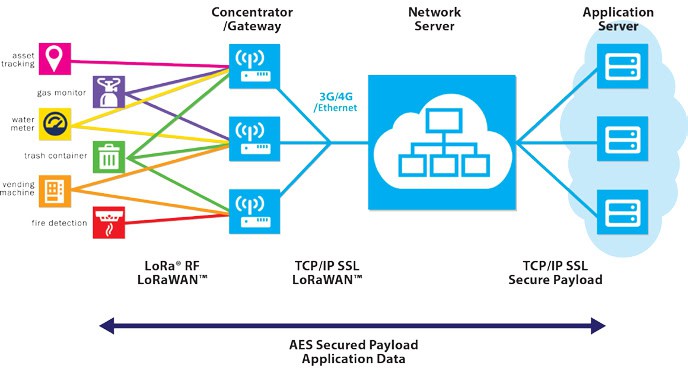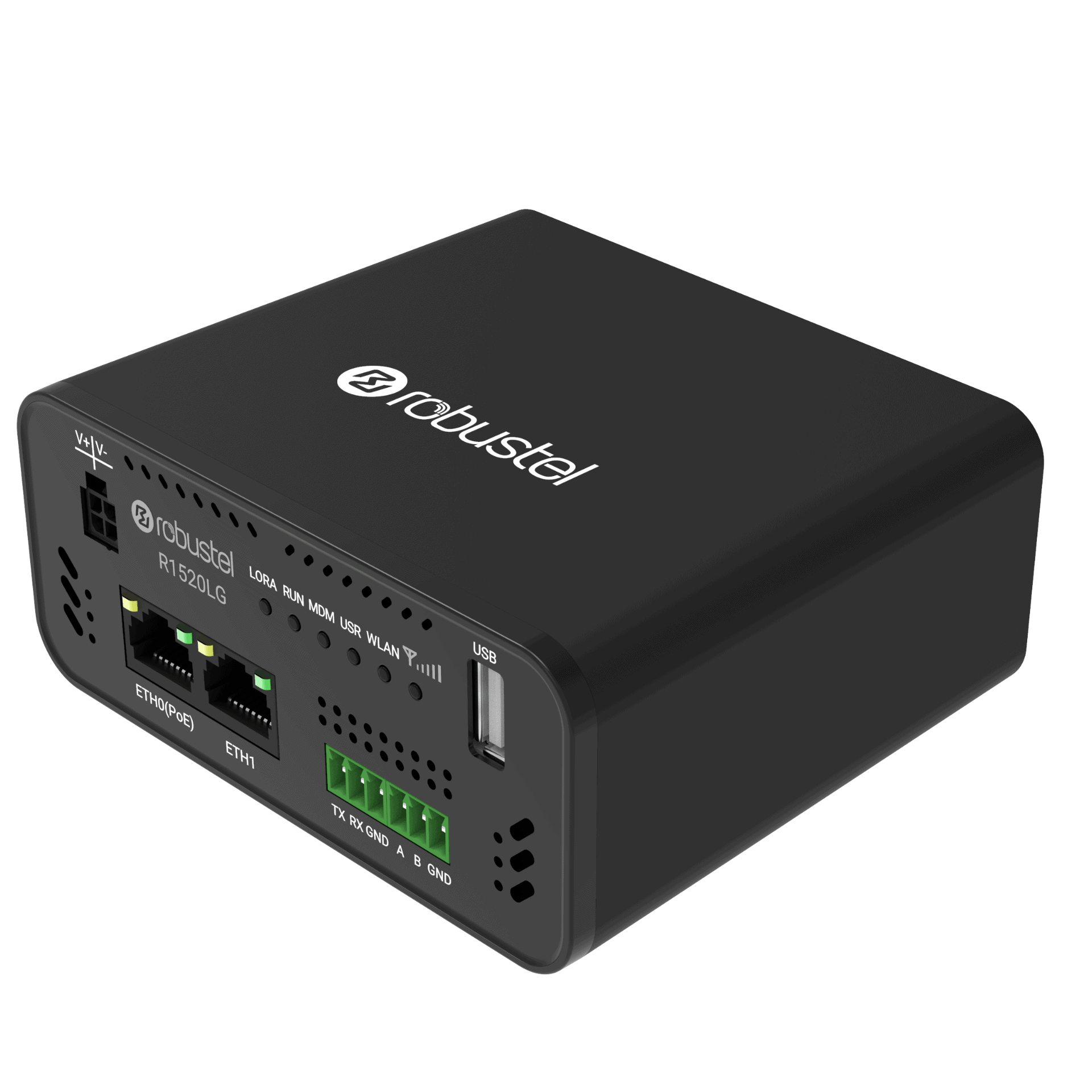Private LoRaWAN for Smart Farm Sensors with the R1520-LG
A Robustel Application Example
Application Example – Fast Facts
Industry
Agriculture, Environmental Monitoring, Smart Farming
Product(s)
R1520-LG LoRaWAN Gateway, RCMS
Challenges
Large properties need long-range, low-power sensing for soil moisture, tanks, gates, and weather—often far from power and LAN. Running Ethernet or extending Wi-Fi to every point is impractical; battery life and coverage are the constraints.
Expected Outcomes
A private LoRaWAN covers paddocks and assets with battery sensors that report reliably over kilometers. Data flows to the grower’s dashboards through a single, auditable backbone, with clear visibility and remote management from day one.
One network for the far edges of the farm
When decisions depend on conditions in the back blocks—soil moisture at depth, tank levels, gate state, wind and rain—you need a network built for distance and battery life. LoRa (the radio) and LoRaWAN (the secure networking layer) are designed for exactly this: infrequent, small messages that must travel far and sip power.
With the R1520-LG as a compact, cabinet-friendly LoRaWAN gateway (cellular or fixed backhaul), you can deploy sensors wherever they make agronomic sense, not just where there’s Ethernet. Data moves from field to cloud through a backbone you own and understand, and operations stay simple enough to grow by field, season, or site.
Business Challenges
Building a sensing footprint across paddocks is an operations problem before it’s a data problem. Most sites can’t justify trenching power or extending Wi-Fi to every sensor. Public networks may not reach the valleys you farm. What you need is a wide-area layer that is power-efficient, predictable to operate, and easy to scale as use cases grow.
- Coverage vs. cost: Long runs of Ethernet or point-to-point radios: costly to install and maintain.
- Battery life: Sensors must run for years, not months.
- Heterogeneous sites: Tanks, gates, soil probes, and weather nodes sit in very different RF conditions.
- Data custody: Many growers prefer to keep the network private while integrating with their chosen LoRaWAN network server (public or private).
- Operational clarity: Simple rollout patterns, clean monitoring, and straightforward troubleshooting across seasons.
Solution Overview

We anchor the design on a private LoRaWAN with cellular or fixed backhaul, sized to your paddocks and terrain. Gateways go high and clear; sensors are enrolled with consistent profiles; integration is tuned to your LoRaWAN network server and downstream dashboards. The outcome is a backbone that is easy to deploy, verify, and scale.
- Gateway placement & RF plan: Mount R1520-LG (or LG5100 for higher channel density) high and clear; choose omni antennas for general coverage or directional for distant paddocks.
- Backhaul & server choice: Use 4G/LTE or fixed WAN to reach your LoRaWAN Network Server (private or public); keep data ownership and policy where you need it.
- Mixed estates supported: Combine LoRa sensors with existing Modbus/I/O through the same site backhaul if required.
- Operations & change control: Use RCMS for monitoring, alerting, and firmware/config changes at estate scale; document hotspots and optimize antenna/placement iteratively.
- Security & auditability: Private network, clearly defined points of ingress/egress, and versioned changes that are easy to review later.
Examples of what you can monitor and control on a farm with LoRaWAN
Soil & irrigation
- Soil moisture/temperature (multi-depth) sensors: Schedule irrigation by zone; flag dry layers before stress shows in canopy. Typical cadence: every 15–60 min.
- Soil salinity/EC probes: Track salt build-up in irrigated blocks and adjust leaching fractions.
- Line pressure & flow on mains/submains: Detect leaks, blockage, and under-performing pivots.
- Valve/solenoid actuators: Trigger zones or fertigation events from the control system.
Water assets
- Tank/bore level (ultrasonic or pressure transducers): Prevent stock water outages; plan tanker runs; protect pumps from dry running.
- Canal/ditch level and weir gates: Keep flows within allocations; manage storm events.
- Water quality (pH, EC, dissolved oxygen, turbidity) in dams or ponds: Protect aquaculture and spray water quality.
Weather & microclimate
- Rain, wind, temperature, humidity, solar radiation (compact met stations): Drive spray windows, disease models, and heat/frost alerts.
- Leaf wetness in orchards/vines: Trigger fungicide timers and canopy management.
- Frost posts (air/soil temperature at multiple heights): Prioritise fans or irrigation for cold pockets.
Livestock, fences & perimeter
- Gate/reed switches and fence voltage monitors: Know when gates open or when an energiser drops.
- Water trough level and pump shed door status: Reduce patrols; catch failures early.
- GPS livestock tags (LoRaWAN-based): High-level movements, muster support (cadence depends on battery budget).
Crops, storage & processing
- Grain silo level, temperature, CO₂: Prevent hotspots; schedule outloads; reduce spoilage.
- Cool room temperature/humidity and door state: Verify cold chain; alert on drift or propped doors.
- Fuel bowser usage (pulse counters) and genset status (run hours, vibration): Reconcile fuel and maintenance.
Security & infrastructure
- Motion, tilt, and vibration on remote assets (pumps, tanks, gates): Deter theft and vandalism.
- Asset trackers for trailers and implements (low-rate position beacons): Recover gear; improve utilisation.
- Power monitoring (single or three-phase): See outages at sheds or pumps without a site visit.
Note: Robustel supplies the gateway/backhaul and fleet operations. Sensors are sourced to suit your agronomy and compliance needs; we help you integrate them into your LoRaWAN Network Server of choice and downstream dashboards.
Expected Customer Outcomes
What success looks like should be obvious on day one and provable at audit. Field teams get sensors where they need them; operations get a network that behaves predictably; management gets trusted data to inform irrigation, inputs, and labor.
What success looks like for the key stakeholders (Farm Manager, Operations Manager) and the secondary stakeholders (Installers, Service Partners):
- Farm/Operations Manager: Wide-area sensor coverage with multi-year battery life; fewer drive-outs to check tanks and gates; better timing of irrigation and inputs.
- Data/IT Lead: Private LoRaWAN under clear governance; clean integration to chosen network server and analytics; estate-wide visibility.
- Installers/Service Partners: Repeatable mounting and enrollment patterns; known antenna options; RCMS access for remote checks and updates.
- Finance/Procurement: Lower total cost than trenching/powering outposts; scalable in blocks without redesign; clear vendor responsibilities.
Featured Products
Robustel R1520-LG LoRaWAN Gateway

RCMS Cloud Device Management

Talk to an Expert
Plan your private LoRaWAN. Share a sketch of your paddocks, sensor list, and mounting options we’ll return a gateway placement draft and a backhaul plan you can deploy quickly.
